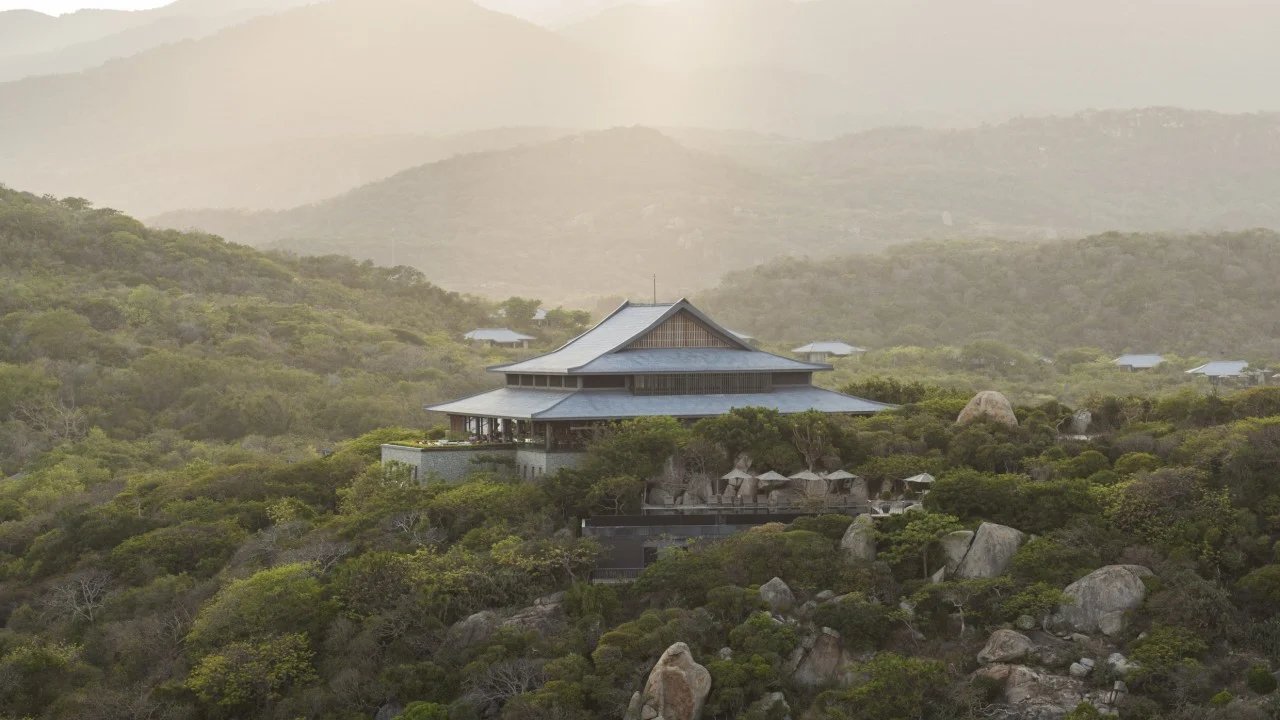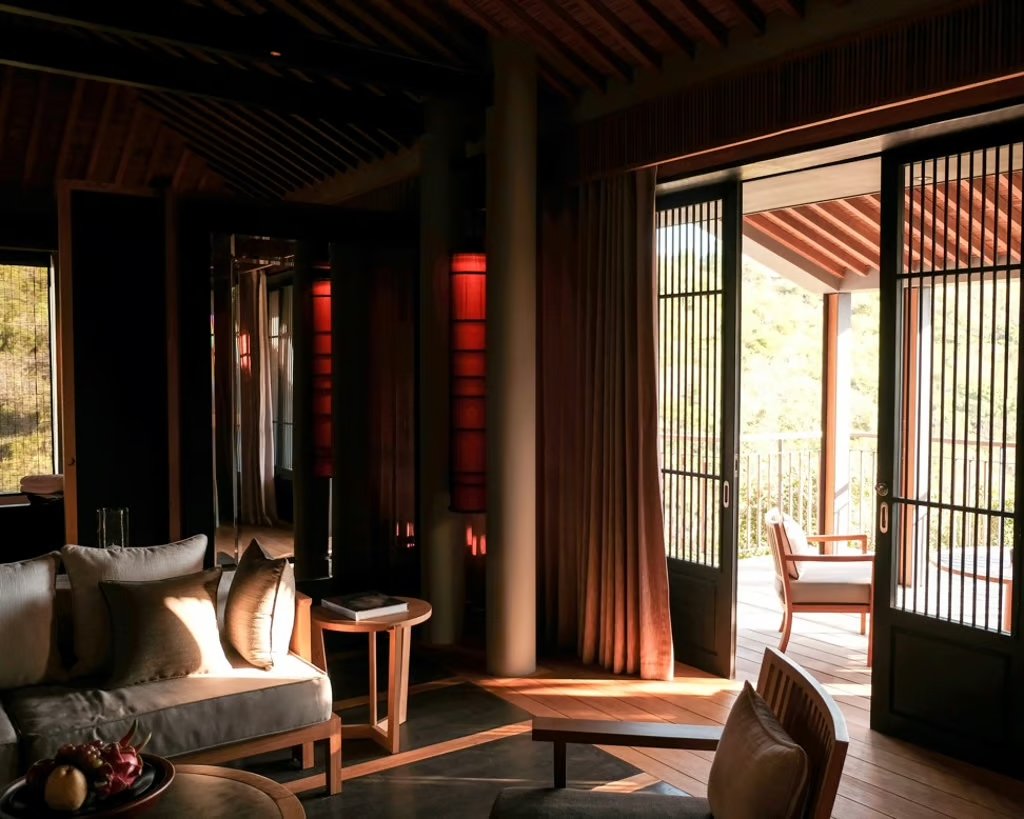Review / Amanoi, Aman’s luxury resort in Vietnam – where there is no shortage of adventures
Peaceful residence in the Vinh Hy Bay hills is just right for couples or families who want to keep adventurous activities an option
The Japanese word komoberi translates to “sunshine filtering through leaves”. As the sun rises at 5.16am over Vinh Hy Bay hills, the residence at which we are staying – in Amanoi, Aman’s luxury resort in Vietnam – is dappled in sunlight, in a way which brings komoberi to mind.
“Golden hour” light casts strong shadows through iron-barred sliding doors, and however clichéd it may seem, the only thing you will hear are bird songs. You cannot escape the reality that you are in the middle of nature and it is embracing you … firmly. Aman is the Sanskrit word for “peace” and noi is the Vietnamese word for “place” after all.
Imagined and realised by Jean-Michel Gathy of Denniston Architects in Kuala Lumpur and his team, the design is inspired by Vietnamese village architecture, however the Zen element of Japanese aesthetics is not lost here.
The flight from Hong Kong to Cam Ranh international Airport near the city of Nha Trang took about 2 hours – Amanoi is the closest Aman property to Hong Kong. Another 70 minutes in a minivan with seats resembling massage chairs, propped with cool wet towels, peanuts, dried mango and water, took us all the way through winding coastal roads towards Nui Chua National Park. We were treated to a glorious sunset that set the ocean aflame as we made our way to the destination.
There were no bells and whistles when we turned off the main road into Amanoi’s 100-acre grounds. A simple sign with its name was the only indication of the resort ahead. Groomed hedges led a white paved road to the entrance where our host – with a line-up of smiling butlers clad in white – awaited us at the Central Pavilion of this luxury facility.
It was already dark when we arrived and the tall grey columns that lined the huge corridor of steps towards the lobby entrance glowed in warm candlelight and soft lighting. There is no denying that this sight of the hotel was designed to impress. “It’s even more beautiful during the day when you can actually see the hills,” said Amanoi’s communication director, as we reached the first platform devoid of any external walls to give an unobstructed view of the wooded hills outside. Another turn up a flight of stairs brought us to the Main Restaurant where we were to enjoy our first dinner in Vietnam.
We stayed at their 5-bedroom residence at a rate of US$5,800 a night excluding taxes and fees, which came with a separate, communal living and outdoor dining area with infinity pool on a timber sun deck that occupied 1,000 square metres (10,764 square feet). Throughout our stay, Dur – our very own butler and buggy driver – tended to our every whim and need 24/7.
Each “bedroom” is a pavilion, and three of the four walls are floor-to-ceiling window panes. An en suite his-and-hers-bathroom partitioned at the end of the room comes with a sizeable bathtub, an impossibly well-lit toilet cube, and a separate shower area that has a door leading out to the balcony from which I have a sliver of a view on the bay.
There is little chance of your privacy being invaded unless another media colleague, having incorrectly identified your lodging as hers, stumbles into your patch and the pavilion by accident. That is the downside of every room having an identical design. Sometimes wildlife (a gecko, a beetle, bird song) makes its way into the rooms, but since we were inside a pristine nature park, it’s all part of the deal.
Luckily, this region is the driest in the country and encounters with mosquitoes (or so I was told) are relatively scarce. It would have been preferable were the locks less fiddly. I constantly had trouble locking the front door whenever we went out for activities, so I ended up not locking up at all and banked on the remote and private nature of our accommodation diminishing the chance of things going missing.
The resort is only 6 years old, but the effects of its presence on neighbouring communities are pervasive in the cultural activities available to guests. From going on morning hikes through the jungle above Broken Bridge village where electricity has yet to come, to enjoying local dishes prepared by Amanoi staff in the courtyard of one of the oldest traditional houses called “Ong Bay’s house” – locally known as a nha ruong (traditional wooden house) – in nearby Vinh Hy town.
Ong Bay, the owner of the property and local elder, has an ancestral history going back to when his family (one of many who fled the Hue imperial court during the reign of the powerful Nguyen dynasty) settled in the protected harbour that is now known as Vinh Hy. This is where we had our second dinner where Amanoi staff cooked in traditional clay pots on a bamboo platform in the middle of Ong Bay’s courtyard.
On another occasion over a Chef’s Table dinner, Nicolas Pillet, general manager of Amanoi, shared some tongue-in-cheek anecdotes of his time at the resort. He did not name any of the celebrities who had stayed there before, but referred to a distinguished couple who wanted to check out after two days in their week-long booking. It was too close to the lavish comfort they enjoyed at home in Monaco, they said. Well, how was a general manager of a luxury resort supposed to respond to that? Nothing can be more flattering than guests feeling so at home, to the point of comparing the property with one of the most lavish princedoms in the world.
Photo: Hill Choi Lee
Mexican chef Bernardo Collazo prepared an intimate dinner of fine Japanese cuisine at the Rock Studio. The studio is a relatively new addition, having been completed at the end of 2018. It is a room with an open plan kitchen facing glass doors that open up to a steep terrace. The view took our breath away. Giant red rocks framed the dazzling blue waters of the bay below – and Amanoi made full use of this. Surrounded by the roots of old trees, bush covering rough boulders and natural light that seeps in from glass doors on all four sides, it was in this studio where they offered us cooking lessons by chef Son.
Great food is often accompanied by an equally impressive workout. One morning we were spirited to the resort’s Lotus Lake where Amanoi’s renowned spa facilities are located. As we walked past the spa’s reception through double doors into the open area beyond, we became aware of the pavilion in the lake where our instructor, Samanta Duggal, who has taught yoga, jazz technique and Bharatnatyam for two decades, awaited us.
For a novice, the yoga session was enlightening. Easy to complete but strenuous enough to keep veterans happy. Each month, the resort invites different teachers and instructors to keep their guests’ minds and bodies nimble. The pavilion, we were told, could also be turned into an intimate candlelit dining area on request. Spa houses are strategically placed around the lake, some of which can accommodate up to four people.
A more strenuous activity lay in store for us the next day. We were treated to a trek that started at Broken Bridge – a nearby village – to have “jungle tea” with an ethnic Raglai’s family (an ethnic group in Vietnam). Disappointingly, the trail was littered with snack wrappings and semi-empty cups. Once at our destination though, the reception was warm and welcoming after an hour’s hike in the withering June heat. Soft shell crabs and an assortment of local fruits over Chinese tea were served and we relaxed in the shade of a giant tree. Everyone forgot, albeit briefly, that we had still to make our way back down the rocky, leafy trail from where we had come.
The afternoon was more leisurely: a lunch picnic at Suoi Sau Beach – Amanoi’s private stretch of sand accessible only by speedboat. Snorkelling gear was provided and one of us daringly braved the choppy waters to see crabs and sea life. The picnic afterwards was a welcome respite after an active morning.
After a couple of hours, we returned to Amanoi’s beach club. The facility on the beach is an extension of the resort where guests have their lunch and swim peacefully in the pool facing the waters, or take part in watersport activities provided by the resort.
After three nights and a 90-minute spa session on the morning of our departure, it was hard to let go of the luxury we had grown accustomed to during our short stay at Amanoi. This is a discerning corner of Vietnam perfect for couples or families who want to keep adventurous activities an option. It is also one that will not easily be forgotten.
Original article published on South China Morning Post (Jul 2, 2019)


